Feature
Modeling Collaboration for Learning
Selected Models of Educator Professional Development from the Science Museum of Minnesota
Connected Science Learning November 2016-January 2017 (Volume 1, Issue 2)
By Lauren Causey, Shannon McManimon, and Emily Poster
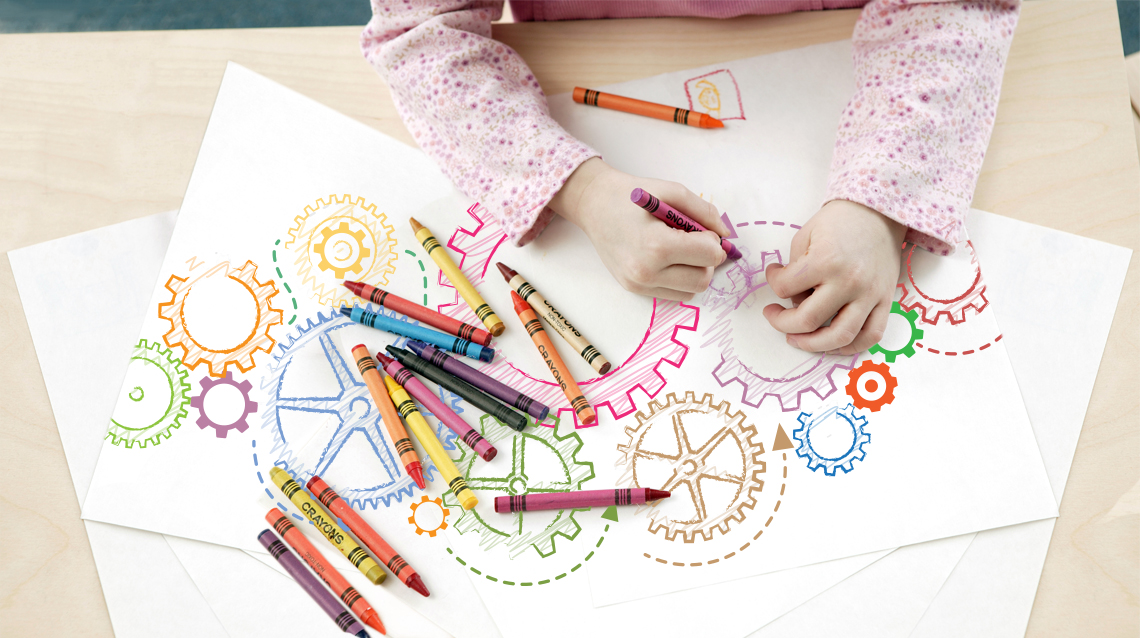
The Science Museum of Minnesota’s offers a well-developed model for implementing the Engineering is Elementary curriculum in Minnesota school districts for grades K–5, as well as a program for preservice teachers and teens called Linking Educators, Youth, and Learners in Computational Thinking.
The Science Museum of Minnesota (SMM) leverages a professional educator team (“instructors”) comprised of about two dozen individuals who facilitate both formal and informal educational programming in the museum, in K–12 classrooms, and at community-based sites. The experienced instructors of SMM’s Lifelong Learning Group bring innovative programs to both students and their teachers. Recognizing that long-term experiences can have a profound impact on students and teachers, SMM works to develop multiyear relationships based on collaboration. This article focuses primarily on SMM’s well-developed model of implementing the Engineering is Elementary (EiE) curriculum in Minnesota school districts, but also uses a few examples from a new program called LinCT: Linking Educators, Youth, and Learners in Computational Thinking. After describing these two programs, we highlight lessons we have learned about effective professional development (PD) for both informal instructors and formal classroom teachers. Effective PD at SMM builds relationships grounded in strong communication, engages new models for collaborative learning rooted in actual classroom settings, and offers important considerations for informal educators’ own PD and preparation for work with classroom teachers and students. These new models for collaborative learning use knowledgeable museum instructors as master teachers who demonstrate instruction of the EiE curriculum in local classrooms or use museum-hosted summer camps as clinical teaching experiences for novice (and preservice) teachers. In both these models, informal and formal teachers learn through hands-on teaching work with students and colleagues.
Program Descriptions
EiE—developed by the Museum of Science, Boston—is a hands-on engineering curriculum for elementary students. SMM has partnered with four school districts in the metropolitan Twin Cities area in Minnesota to implement this curriculum, including providing teacher PD. A crucial component of this PD occurs as SMM instructors model the EiE curriculum for local teachers in two-week “residencies” in their kindergarten to fifth-grade classrooms. During a residency, an SMM instructor joins an elementary classroom to teach an EiE unit. (Unit selections for each grade are made at the school district level.) The SMM instructor models the EiE curriculum and engineering pedagogy, while classroom teachers observe and/or coteach as best fits their personal learning styles. The SMM instructor spends one hour per day with each classroom for six to eight days over two weeks. Teachers are encouraged to ask questions and share ideas with the instructor throughout the residency and in reflective conversations postresidency.
During the school years following a residency, classroom educators teach EiE themselves, carrying out the goal of making EiE a long-term, sustainable curriculum implementation program (Roehrig, Kruse, and Kern 2007). Additional teacher PD (for example, see teacher tips) is provided at various stages of implementation. Although many school districts use EiE, what is important about SMM’s work is the long-term partnerships between museum and school district leaders. Strong relationships with district staff allow SMM to respond to districts’ changing needs. The program also addresses the objectives of the project funder—the Cargill Foundation, which has granted a total of nearly $1.5 million for the current three-year program cycle.
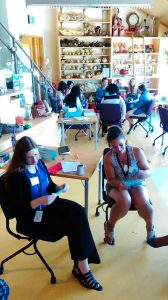
Also based at SMM, LinCT is a National Science Foundation (NSF)/Innovative Technology Experiences for Students and Teachers (ITEST)–funded, three-year project with a total cost of $1.2 million that is creating a professional learning and teaching community focused on technology and women. The all-female community includes preservice teachers (primarily in elementary licensure) from two local universities (Metropolitan State University and St. Catherine’s University), as well as high school students; all are employed by the museum and have learned various coding programs such as Scratch. In summer 2016, they taught or assisted in SMM’s technology-based, weeklong summer camps. During the school year, the members of this professional learning community work with SMM instructors to deliver technology content to local schools in an arrangement similar to the structure of EiE residencies. Building upon their experiences teaching in summer camp classes, the preservice teachers switch to formal schools to teach technology content. Their two-week “tech residencies,” held at local, under-resourced schools, serve as an additional way for LinCT to broaden students’ access to new technologies while providing a model to the host classroom teachers for new pedagogies.
The LinCT project is unique in that very few museums are working so deeply with emerging teaching professionals in partnership with universities. Further, the coteaching models implemented in both summer camps (informal learning spaces) and K–12 classrooms (formal learning spaces) will enable us to ask questions about what teachers from those respective settings can learn from each other and what emerging classroom educators can learn from teaching in informal learning spaces. Lastly, an additional opportunity provided by LinCT is the inclusion of high school youth as program assistants. We hope that this aspect of the project will yield new knowledge about mentoring among cohorts who have similar experiences (such as being female) but who also differ from one another (such as age difference). Referred to as a near-peer mentoring framework, it will help us understand ways that teen girls use role models as inspiration to pursue careers in technology fields or in teaching professions.
Both projects strive to build the capacity of STEM educators—both formal and informal—to collaborate, learn from each other, and enhance student learning. We are testing the hypothesis that their success rests on strong communication and using new models for professional learning that are situated in previous research across the field.
Building Relationships Grounded in Strong Communication: Before, During, and After Collaboration
The EiE project team follows a deliberate process to collaborate successfully and ensure that districts’ needs are met during each stage of the curriculum implementation process. We know that the critical time for collaboration is not only what happens in the classroom, but also the time we spend preparing schools and teachers for residencies and debriefing after programming (Onkka 2014). Process and content are equally important, and the EiE project team has systems for continually improving both. A diagram of the curriculum implementation model shows the four steps that take place prior to, during, and following the engineering residency programming: partnership, implementation, sustainability, and leadership/innovation.
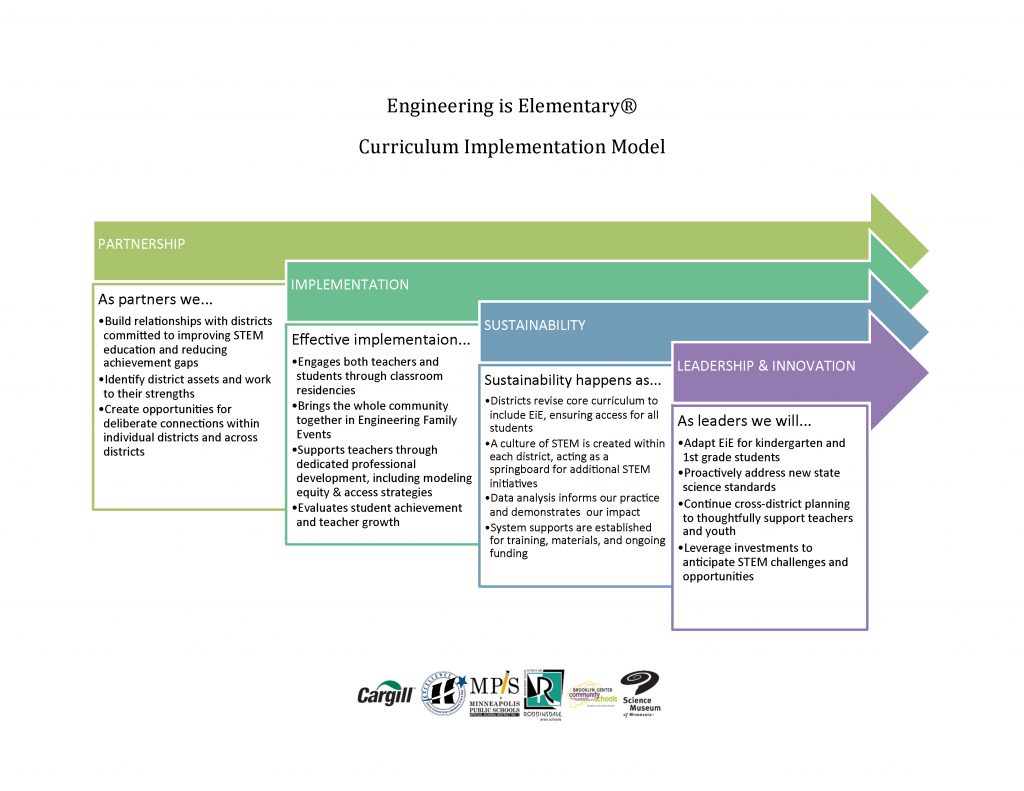
As the EiE team develops partnerships, it discusses shared values with district leaders, making clear how the museum and the districts each bring strengths to our respective efforts. We establish that the curriculum implementation program will be a give-and-take relationship and that we can both benefit from the expertise the other offers. Clarifying roles, especially that of the classroom teacher during a residency session, is an important step. This process leads to mutual respect as well as clear, common goals that guide teachers in understanding the intent of the program and informal instructors in understanding the priorities and needs of school districts, teachers, and classrooms. Mary Jane Adams, Teaching and Learning Specialist for Robbinsdale Area Schools (one of the four partner districts), commented that this partnership with SMM “gives our teachers really strong tools and strategies for their toolbox to help our students engage in the learning of [the] engineering design process. … This partnership engages our teachers in deep thinking and learning about their instruction, and whenever our teachers are thinking about their instruction, our students benefit.” (See more students, teachers, and administrators talking about the impact of EiE in a video below from the Seven Dreams Education Foundation.)
Indeed, data from teachers indicate the benefits of of the model’s implementation—that is, the residency programs and PD sessions. In the most recent grant funding cycle, 94 teachers reflected on their residency experience in a survey. The vast majority of teachers (97%) agreed or strongly agreed that they are committed to teaching engineering and technology to their students. Furthermore, 98% agreed or strongly agreed that they are confident in their ability to teach using problems that have more than one right answer. Further, 78% either agreed or strongly agreed with the statement, “I am willing to help other teachers learn to teach the EiE curriculum when it is implemented districtwide next year.” This may point to the contributions that classroom teachers can and are willing to make toward the long-term sustainability of EiE within their schools, particularly once the current grant funding is complete. From these surveys and from conversations with classroom teachers and SMM instructors, we have seen the importance of ongoing relationships built between teachers, districts, and SMM, as evidenced through mutually defining what success looks like in an EiE classroom, including academic learning, social interaction, and student engagement. Finally, the leadership/innovation phase of the model ensures that SMM’s work can be adapted to remain of utmost relevance as districts’ needs and capacities change and as new research indicates other priorities for action.
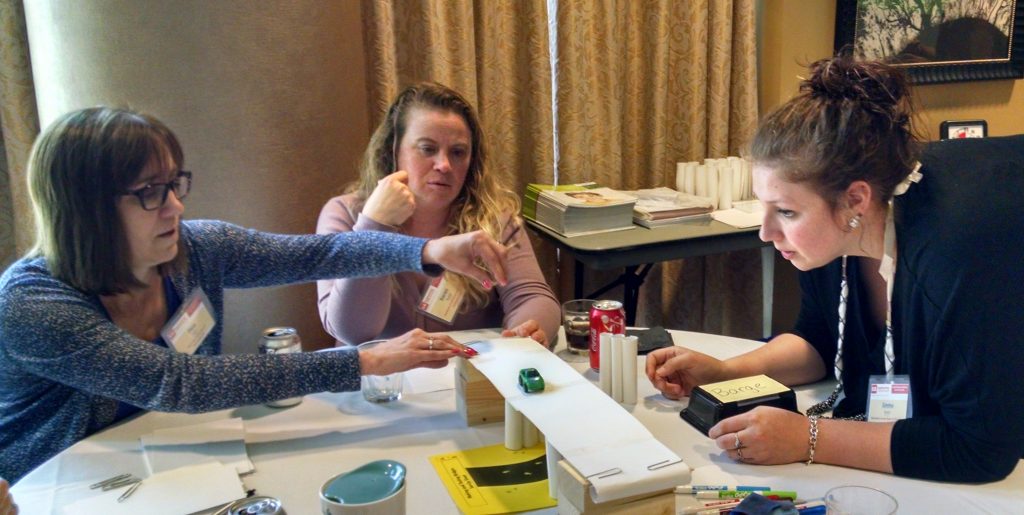
Practice-Based Learning: Professional Learning Communities Rooted in Authentic Classroom Settings
A common critique of educator PD is that it is disconnected from the daily work of teaching and engaging with students. Often involving teachers gathered in the gym or auditorium for a day or half-day, these “one size fits all” models, commonly featuring “outside” experts, are not necessarily directly applied to the needs of an individual teacher’s classroom or students or based on adequate knowledge of local experiences and needs (see, e.g., Randi and Zeichner 2004). The residency model developed around EiE is different: It is job-embedded. Learnings from this model also informed the structure of LinCT.
Although teachers often do come to SMM to learn, SMM instructors also go into schools to directly teach EiE units. This model combines teacher PD with engaging, hands-on experiences for students. During a residency, an SMM instructor teaches directly in the classroom a specific curriculum unit over the course of two weeks. The classroom teacher observes in real time, with actual curriculum and students, better preparing her to teach the same curriculum on her own in the future. This model makes the curriculum more sustainable for districts and does not overstress already full PD days or require hiring a substitute teacher when an educator is out of the classroom for PD.
Interviews with teachers who participated in residencies led us to conclude that “a residency uses a powerful combination of modeling and observation in an authentic environment—their own classroom” (Onkka 2014, p. 1). As one teacher said, with PD delivered in an adults-only setting, “probably 7 out of 10 times, it does not work the same” when the teacher brings it back to the classroom, but with a residency, “you were able to see kids in action with everything.” When teachers observe their own classroom and see firsthand how much students learn and enjoy what they are learning, much of the guesswork of a new curriculum is erased. They see how hands-on or inquiry-based pedagogical strategies are enacted, and observe challenges that they had not foreseen but can then anticipate when they teach the unit. They feel more prepared and confident, which is particularly important in teaching engineering, a subject that is unfamiliar and frequently intimidating for elementary classroom teachers. Of course, this is important for student learning. As one teacher said, “Had I not had that experience with [a resident], I probably would have done the activities and not necessarily gotten to the real questions that we needed the students to think about.” During residencies, teachers are often highly involved with the lesson, engaging with students rather than working at their desks; they see the power of the model and how it helps their learning as a teacher who will implement the curriculum in the future. To engender even more confidence among classroom teachers following the residencies, SMM and/or districts occasionally host an additional PD workshop for teachers following the residency. Although the classroom teachers are primarily observers during the residency, during the postresidency workshop, the classroom teachers are actively using the curriculum, participating in engineering design challenges in small groups, and discussing what adaptations they might make to the curriculum to meet the needs of their students. The workshop serves as an opportunity for teachers to ask further questions of the EiE project leaders at SMM and to share ideas with one another.
Further, observing is powerful not only for the classroom teachers, but for the informal educators as well, who note that there is “value in seeing us be observed.” Being observed can be intimidating for teachers; implicitly building observation (of an SMM instructor by a classroom teacher) into the model may reduce this worry and demonstrate what can be learned by watching another professional, including sharing what works and what does not, and providing new strategies and ideas. Additionally, SMM’s informal educators have stated that it is important to know what it is like to be observed; this provides insight into the daily work of classroom teachers and asks instructors to reflect on their own practice. The residency model may thus counter the isolation that many teachers, both formal and informal, feel. In other words, teaching in front of others and watching someone else teach are important for professional growth.
The power of this model (both the residencies and the hands-on curriculum) is supported by student testing data. SMM has been providing EiE PD in this residency format for seven years in multiple Minnesota school districts. At the same time, SMM has also used a more standard PD model, with teachers participating in a hands-on PD workshop and then teaching the curriculum in their classroom. Students whose teachers participated in both models took pre- and posttests for their engineering curriculum unit. Results from t-tests show that students whose teacher had a residency in the previous year showed significantly higher gains in science and engineering than those students whose teacher participated in a PD workshop only. Further, schools report seeing a decrease in the racial achievement gap and an increase in science scores on state standardized assessments after beginning EiE in their districts (Lachapelle et al. 2013). A box plot illustrating the achievement gap finding noted above is available in the Lachapelle report on p. 20 (Figure 7). Mary Jane Adams, teaching and learning specialist for the Robbinsdale Area Schools (one of the four partner districts), asserted, “What we know about Engineering is Elementary is that it deepens our students’ level of engagement. It deepens [engagement] with hands-on learning experiences, and those hands-on learning experiences integrate things like literacy skills and thinking skills and problem-solving skills: those skills that are essential for our students.”
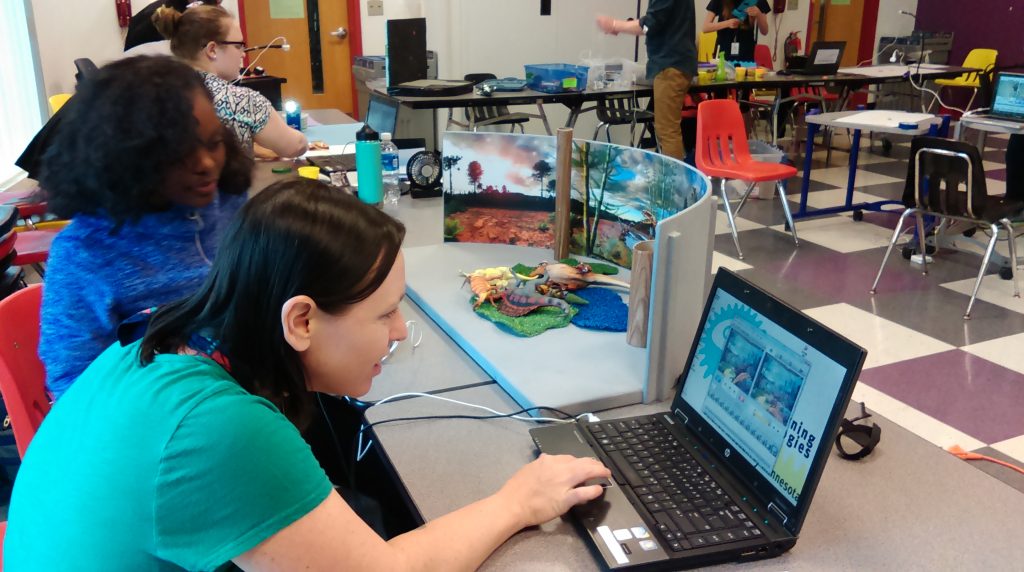
Actual classroom settings for learning and collaboration also informed the development of LinCT in multiple ways. Research studies show that museum settings can be especially enriching, as they allow formal classroom teachers to develop new understandings of educational opportunities in informal settings. For some, experiences in informal settings provide an expanded view of holistic science education (e.g., including more inquiry-based or problem-based learning scenarios than rote learning activities) and lead to shifts in their self-perceptions as educators. For example, preservice teachers who participated in practica in informal science settings have reported gaining confidence and self-efficacy in using hands-on activities, teaching science, being flexible, working with a wider age range of students, or developing a sense of autonomy to try new strategies; they also express a deeper appreciation for working collaboratively with other educators (e.g., Anderson, Lawson, and Mayer-Smith 2006; Jung and Tonso 2006). The LinCT model builds on this and other research indicating that peer-teaching and mentoring are effective techniques to support the formation of professional learning communities (e.g., Brennan and Resnick 2012; Ito et al. 2013; Packard and Nguyen 2003). For example, youth educators from the museum act as teaching assistants and a bridge between museum and classroom settings, as well as between preservice teachers and students. Again, this model builds professional learning opportunities into actual classroom spaces and between educators working in different roles.
What Works for Informal Educators
Informal educators in EiE and LinCT benefit from the team-based nature of their work. A decentralized structure allows colleagues to learn from and with each other on a daily basis. The teams operate as a community of learners in a space where shadowing colleagues fosters both accountability and innovation. A LinCT preservice teacher said that this collaborative, embedded model of learning is, for her, about community: “No question is the wrong question. I feel like in the past, I’d be afraid to ask, because they’d think, ‘Oh, she doesn’t know what she’s talking about, or she doesn’t understand.’”
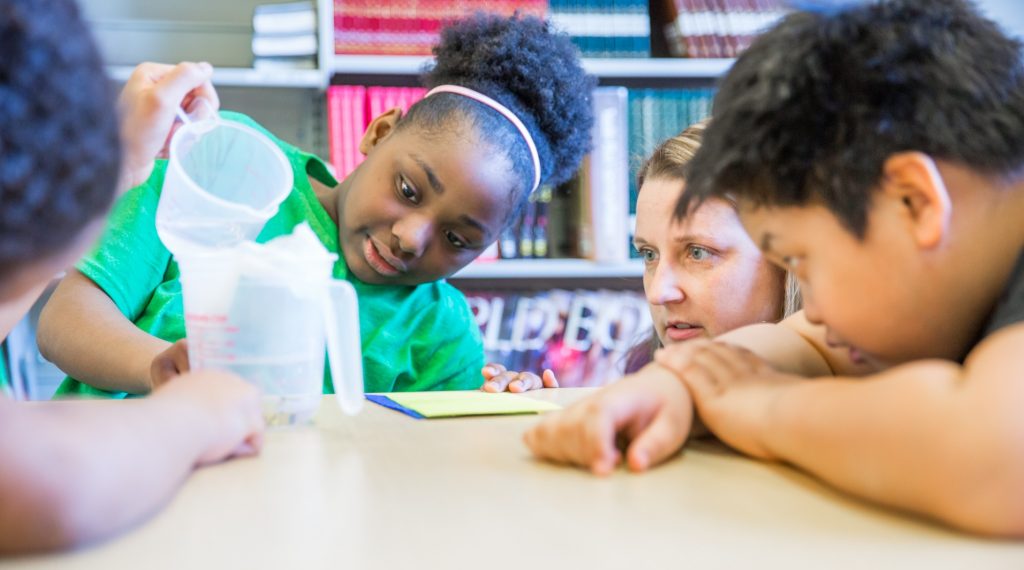
Both projects have also used existing museum programming to enhance their respective models. For example, the EiE project added a focus on equity and access within engineering content and pedagogy. To help put the new plan’s focus on equity and access into action, the Kitty Andersen Youth Science Center (KAYSC)—an in-house youth development program that engages individuals, from ages 14 to 24, who are underrepresented in STEM—was tapped as an internal partner because of its strong focus on social justice. The EiE project team piloted a new residency component in which KAYSC youth paired with and shadowed SMM instructors to observe the local EiE residencies. KAYSC youth were prepared with techniques to structure their observations, focusing on what an instructor did to foster engagement among all students and ways the instructor attempted to address gender and racial inequities in each classroom. Instructors who were paired with a shadow spent time with the youth prior to and after the residency to foster conversation about the lesson plan, talk about what KAYSC youth shadows noticed about the class, and add more context for the choices the instructor made while teaching. In the pilot stages of the shadow program, we gathered informal, written feedback from instructors and shadows about this facet of EiE.
This addition to the EiE program created new learning moments for both seasoned instructors (who gained insight into the youths’ perspectives about the practice of teaching) and for KAYSC youth (who experienced an up-close example of teaching as a career). One instructor, for example, reflected that “it was nice for me to be asked to ‘be transparent about pedagogy,’ since it forced me to pay attention to the small adjustments between classes and to articulate why I thought certain strategies were best for each class.” In her case, having to debrief with a KAYSC youth shadow led to a heightened awareness of the choices she was making while teaching the EiE unit. One KAYSC shadow shared that “being able to reflect during the drive back to the museum was really helpful, both for [the instructor] and me. By being able to reflect right after the lessons for the day were over, we were able to come up with a plan for the next day’s lesson.” It has been an asset thus far to use existing programing at SMM—such as the KAYSC—to identify new audiences that can use EiE as an opportunity for growth.
Similarly, both LinCT and EiE turned to the existing in-house Teacher Professional Development Group (TPDG) to provide a weeklong institute to help instructors, preservice teachers, and high school youth understand educational inequity from a systems-level perspective. TPDG’s theoretical framework addresses inequities within STEM classrooms and STEM education policies, focusing on five lenses: disparities and inequities, curriculum and pedagogy, reconstructing the nature and culture of STEM, identity, and community leadership. The institute not only helps attendees develop new understandings, but it also requires that attendees address—even change—their pre-existing notions of what learning should look like in classrooms. For example, prior to the 2016 summer camps, LinCT educators, youth, and project leaders attended a TPDG institute together. They deepened their sense of community through in-depth discussions and kinesthetic learning activities led by TPDG staff. These changes were documented via self-reflections at the end of each day of the institute, and by semistructured interviews with TPDG staff before and after the institute. For example, after the first day of the institute, a LinCT participant who is in a teacher-education program reflected, “I had many connections today between our learning and past things that I have learned in school. I enjoyed the opportunity to revisit some topics, like growth mindset, and am looking forward to fostering these things in my students.” In addition, a TPDG staff member shared during an interview, “They have such a great community formed, and they’re really supportive of one another and willing to be vulnerable with one another and to share with one another. And that makes an institute just really wonderful.” Being a member of a supportive learning community in which learning new things—and unlearning false preconceptions—is a characteristic of the job of an informal educator at SMM.
Attention to the context of schools is also an important component of how SMM informal educators operate. For example, an EiE residency instructor must consider complex realities, such as a residency teacher shifting to a new grade or school the following academic year, making the residency experience less relevant. Other indicators of school culture, including scheduling intricacies and managing materials, factor into how informal educators constantly work to understand how they can be as effective as possible when working with teachers and students in formal settings.
Doing With, Not For
These models of building capacity in STEM educators are about change and growth in both teachers and students. As one preservice teacher in LinCT said in an interview, “I’ve seen so many changes in myself just in the [first] month of being here.” For her, “it all comes back to growing along with my students, and always thinking outside of that box. And as much as me pushing the students, I want them to push me as a teacher.” Similarly, SMM’s Lifelong Learning Group uses evolving models of PD to push the learning of both informal instructors and formal classroom teachers. Partnership development is a long-term and ongoing process, from first contact to classroom interactions to conversations with school support staff. Likewise, PD is not just about the content of the curriculum; it is about planning and relationships. Effective collaboration between informal and formal educators, according to SMM instructors, requires embracing both chaos and structure; it means doing with, not doing for. This collaborative mindset is sometimes referred to as a “gradual release of responsibility” (Fisher and Frey 2008, p. 24), in which both sides ultimately develop equal authority to flex according to their needs, all the while considering long-term implications.
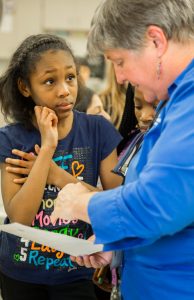
As these examples from EiE and LinCT show, collaboration among formal and informal educational institutions can look different when the goals of a project differ. For the EiE project at SMM, a residency structure works well to improve elementary classroom teachers’ skills in using an engineering curriculum, an often unfamiliar topic. For the LinCT project, an all-female, near-peer mentoring framework is increasing preservice teachers’ confidence with using technology in their classrooms. However, some constants anchor both SMM programs, which lead to their being excellent models of collaboration: ongoing relationship development and clear communication; realistic, practice-embedded learning opportunities; and using the charateristics of and opportunities available in the informal environment for PD.
Lauren Causey (lcausey@smm.org) is a senior evaluation and research associate at the Science Museum of Minnesota in St. Paul, Minnesota. Shannon McManimon (mcmanims@newpaltz.edu) is assistant professor in the Department of Educational Studies and Leadership at the State University of New York at New Paltz in New Paltz, New York, and works with the Department of Evaluation and Research at the Science Museum of Minnesota in St. Paul, Minnesota. Emily Poster (eposter@smm.org) is program developer for Engineering is Elementary at the Science Museum of Minnesota in St. Paul, Minnesota.


